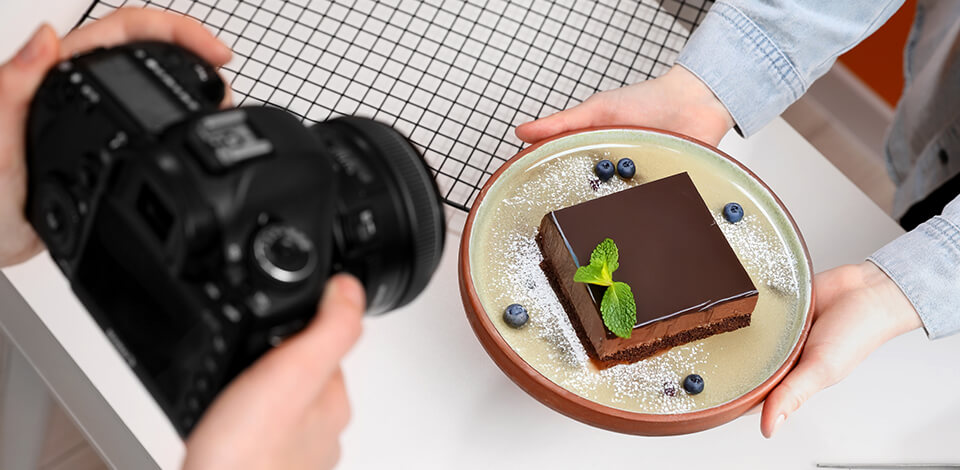
I decided to find the best lens for food photography to ensure I could show off my cooking skills online in the best possible quality. I initially just used my phone, but I quickly realized that I needed a camera.
Even though the image quality was solid, I still couldn’t capture all the details and colors of my dishes despite the amount of effort I’ve put into them.

MY CHOICE
Sigma 24-70mm f/2.8 DG OS HSM Art
★★★★★ (5/5)
It’s among the best lenses for food photography since it provides terrific sharpness, an appealing background blur, and a flexible zoom range. Its f/2.8 aperture is perfect in low light and lets you set a shallow depth of field, ensuring the dishes look eye-catching and beautiful.
The biggest issue with trying to figure out what lens for food photography is best is that I wanted to find a reasonably-priced option that would still deliver the quality I need without breaking my bank.
I wanted to get a model that can snap creamy close-up photos with defined edges, softer centers, and satisfying depth and sharpness. I tend to take photos in natural light, so a wide aperture was necessary too to enjoy an appealing backdrop blur while still getting the necessary light at f/1.8 or f/2.8 during overcast days.
I also paid attention to focal length. I don’t like standing far away from the subject, particularly since I usually place my dish on a small kitchen table. I prefer to stick within the 50mm to 100mm range. Additionally, I prioritized lenses with image stabilization since I mostly work in handheld mode.
When picking from different food photography lenses, it’s important to look at the focal length since it has an impact on perspective, depth of field, composition, and the amount of space required for a comfortable photoshoot. Here’s a look at the most frequently employed focal lengths chosen by food photographers and their purpose:
Amazon: 200+ bought in past month
B&H: 3K+ sold in the past year
Adorama: 2K+ sold in the past year
Best Buy: 1.5K+ sold in past year
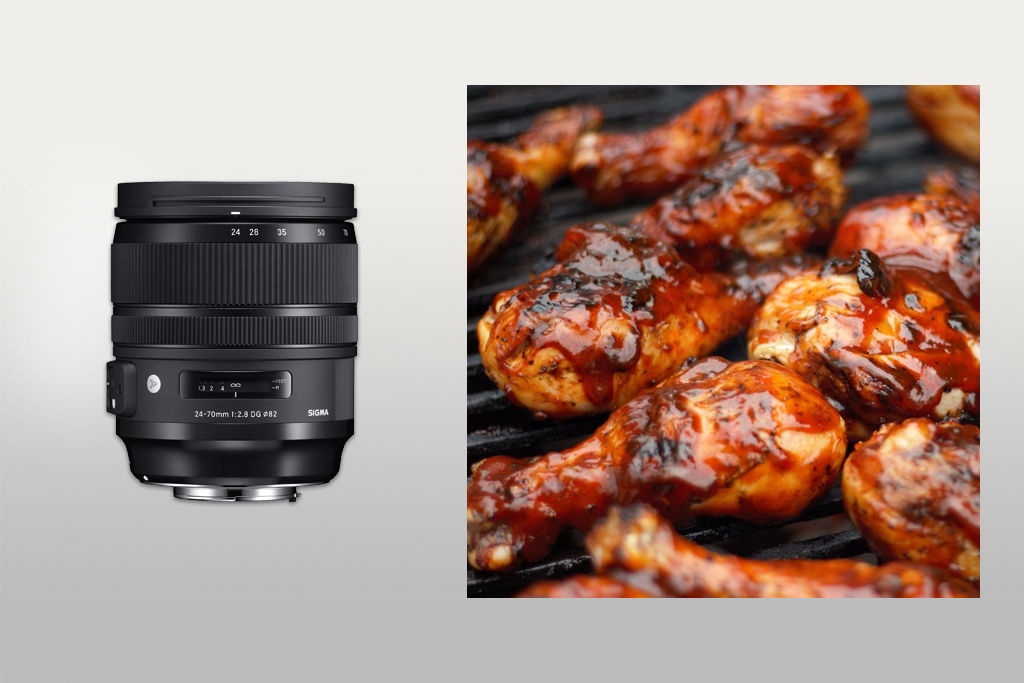
This might be the best camera lens for food photography when it comes to zoom range, covering anything from 24mm to 70mm. It’s suitable for flat lays, 45° angles, and some close-ups without requiring you to swap lenses or get a tripod. Such versatility makes it both budget-friendly and allows you to stay productive and focused on the shooting process.
When trying out this Sigma lens, I put it through several real-world scenarios: a stylized charcuterie board on a vintage table (flat lay at 24mm), served desserts with a reduced depth of field (about 50mm-60mm), and a couple of photos of sliced vegetables at 35mm.
This lens delivers terrific sharpness, and even the wider end barely suffers from distortion. It’s included in the Sigma Art series, which means it produces accurate, crisp colors, particularly if you’re working in natural lighting conditions.
The fixed f/2.8 aperture is perfect for low-light environments. I used it for an atmospheric dinner setting that only featured candles and a bunch of dim string lights, and the lens still performed great. I barely had to increase my ISO, and the implemented optical stabilization is very efficient at ensuring your handheld shots look great even at lower shutter speeds.
Amazon: 2K+ bought in past month
B&H: 28K+ sold in the past year
Adorama: 21K+ sold in the past year
Best Buy: 17K+ sold in past year
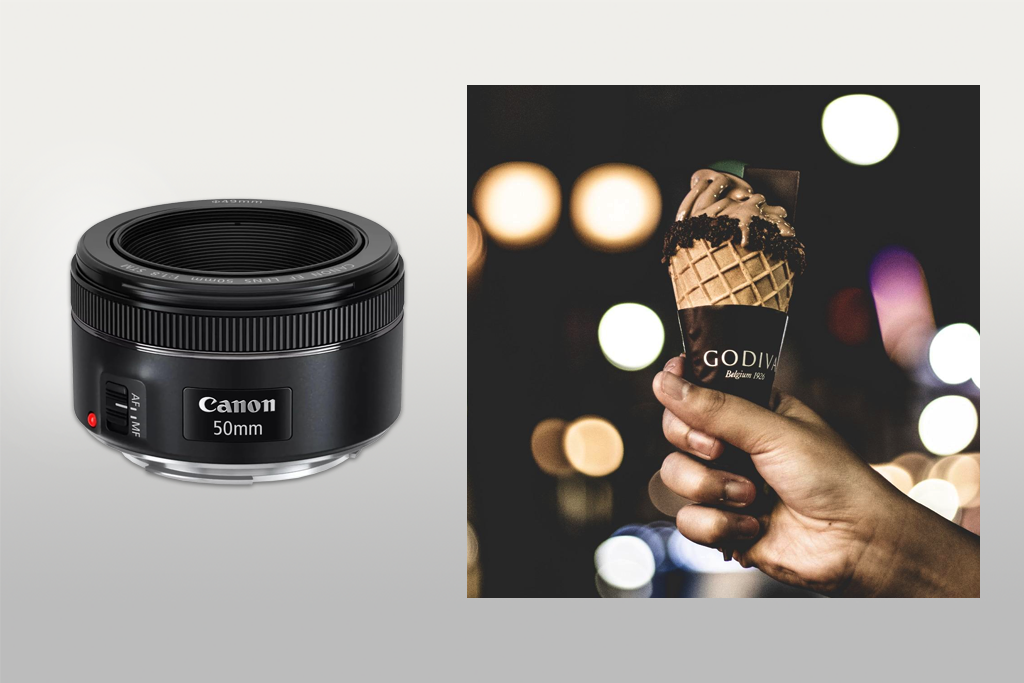
When I was just starting out, I lacked the money to buy the best Canon lens for food photography in the premium price range. That’s how I stumbled upon the Canon EF 50mm f/1.8 STM, often referred to as “nifty fifty.” It’s often used by beginners and even some professional portrait photographers.
I used this model for a two-day photoshoot in my house. I prepared a couple of dishes: a stack of syrup-covered pancakes, a cheese board, and a vibrant salad with different veggies. I combined natural lighting with an LED panel while shooting in both handheld mode and using a tripod.
The 50mm focal length is a perfect fit for taking food pictures, providing enough space without feeling cramped, while also letting you get closer to frame the shot more intimately. The best part about this 50mm lens is the f/1.8 aperture. This allows it to receive a lot of light, making it a good choice for indoor shots since you won’t have to increase ISO too much.
The shallow depth of field is another great feature. It helps create a dreamy backdrop bokeh to focus the viewer’s attention entirely on the dish. When I was taking photos of pancakes, the front of the stack was in full sharpness while the background gradually faded into a subtle blur.
Amazon: 3K+ bought in past month
B&H: 38K+ sold in the past year
Best Buy: 29K+ sold in past year
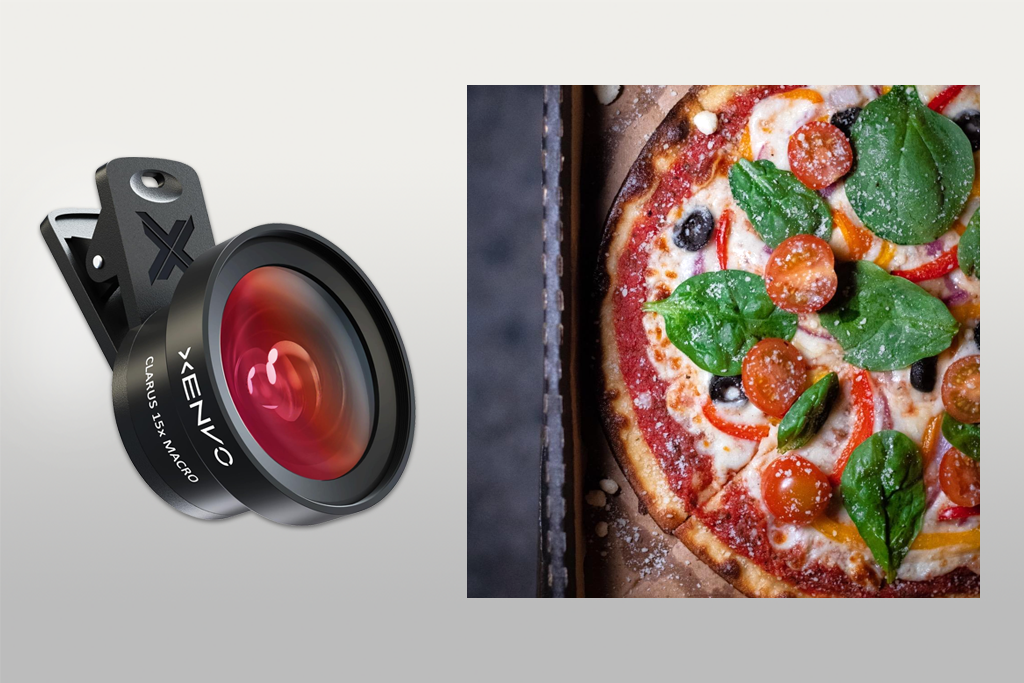
This set includes a pair of lenses: a wide-angle and a macro model, as well as a clip-on LED light and travel case. The first item that caught my interest is the macro lens. I wanted to take some close-up texture shots, like the crust of sourdough bread.
I also enjoyed using the TruView 0.45x wide-angle lens, which allowed me to include a broader scene in the shot. This phone camera lens managed to take beautiful photos without distortions, which was a pleasant surprise considering it’s an add-on lens.
I used it in my kitchen for a couple of days, photographing a couple of smaller details and snack spreads arranged near the window. If you’re shooting with your Android smartphone or iPhone, this might be the optimal lens for macro food photography, as it’s easy to attach and use.
The close-up is incredible, and you don’t lose focus no matter how much you zoom in, enjoying 15x magnification that helps emphasize even the tiniest details of your dishes, like tiny herb specs or sugar crystals.
Amazon: 100+ bought in past month
B&H: 1.5K+ sold in the past year
Adorama: 1K+ sold in the past year
Best Buy: 800+ sold in past year
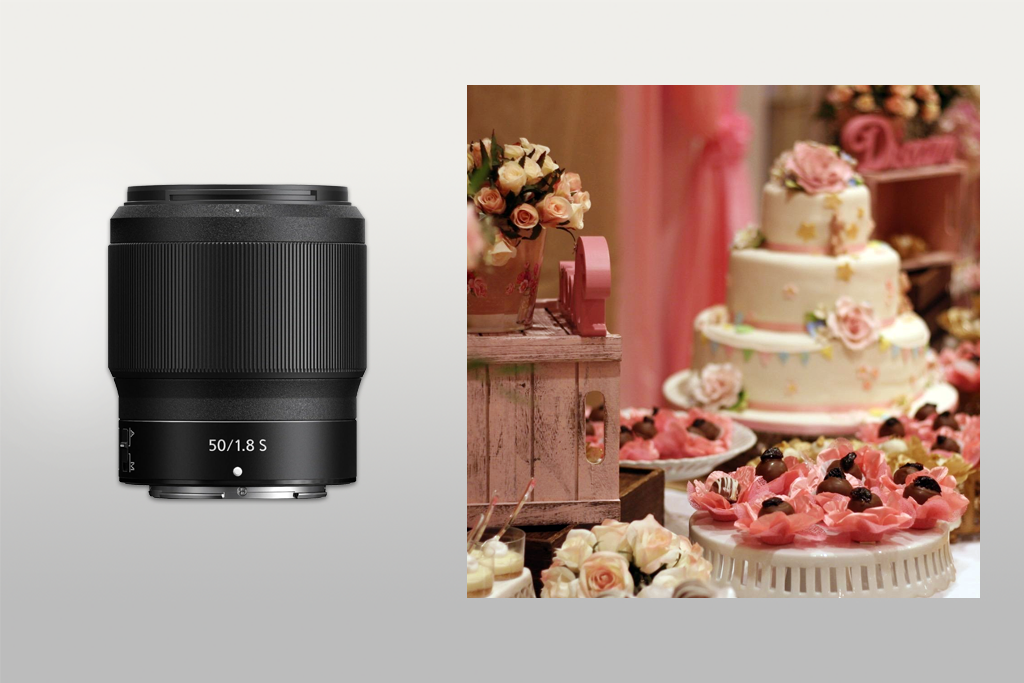
This might be the best Nikon lens for food photography when it comes to sharpness. Even at f/1.8, the photos looked incredibly detailed. The texture of shredded parmesan, the flaky nature of certain pastries, the sugar crystals on a brownie – I managed to capture everything. This lens is perfect for overhead photos that require the entire scene to be in focus.
This model also creates a beautiful bokeh, allowing you to frame your dishes with a dreamlike backdrop to ensure the focus is entirely on the subject, particularly when working at a 45-degree angle. The Nikon lens produces creamy backdrops, ensuring the distracting kitchen props I had on my table faded into the background.
The 50mm focal length provides more versatility than I thought. Even though it’s not as suitable for extreme close-ups as dedicated macro lenses, it can still focus on individual dishes and smaller details when I get closer to the subject. I could also use it to take pictures of people preparing, serving, or eating food to add a narrative component to my shots.
This Nikon lens also offers a sturdy build with dependable weather sealing and a responsive focus – all without feeling cumbersome. If you want a lightweight model that you can carry with you, the NIKKOR Z 50mm is a great choice.
Amazon: 100+ bought in past month
B&H: 1.3K+ sold in the past year
Adorama: 1.1K+ sold in the past year
Best Buy: 700+ sold in past year
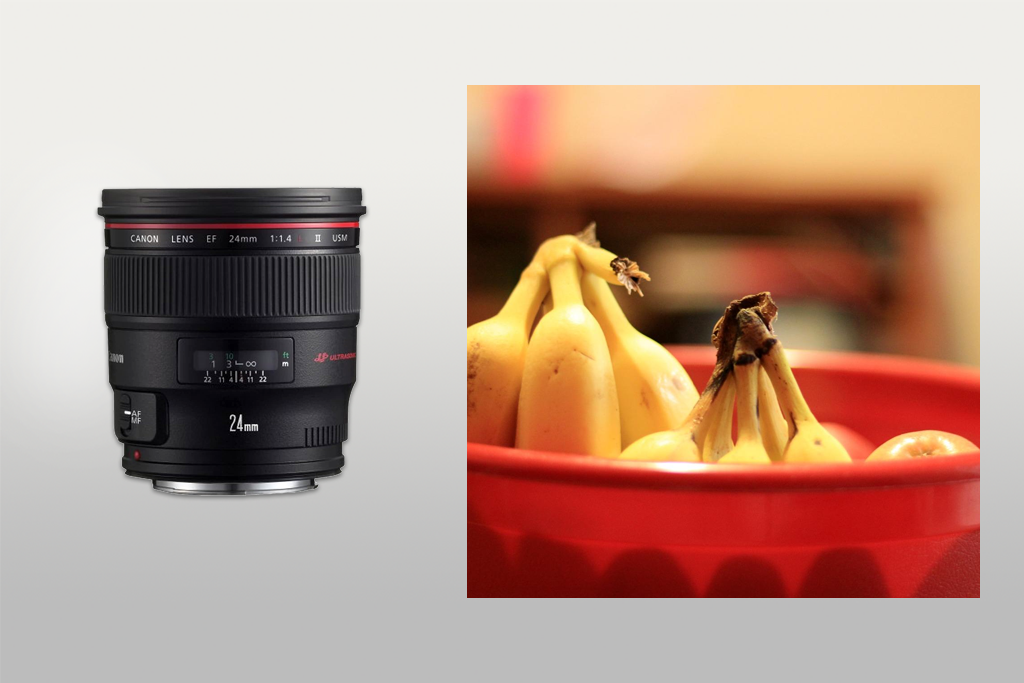
If budget isn’t a big concern, then the Canon EF 24mm is possibly the best lens for food photography. It's sturdy, reliable, weather-sealed, has a fluid focus ring, and the classic L-glass heft. I used it for a bunch of shoots: taking top-down photos of breakfast sets, brunch meals in restaurants with atmospheric lighting, and handheld pics at home near golden hour.
The f/1.4 aperture makes this lens suitable for indoor low-light shoots without having to increase ISO to unreasonable values. Even with a broad 24mm field of view, this Canon lens is great at isolating the subject, which is surprising at this focal length. I created a soft bokeh around my dishes, with the best results being achieved when I was aiming at a 45-degree angle.
When doing flat lays, 24mm is the best lens focal length for food photography. It can capture the entire table with all the props without forcing me up a ladder. Such a field of view makes it easier to tell a story through my photos, showcasing the entire scene without any visible distortion or blurry edges.
Autofocus performance is quick and accurate. The ring-type USM motor adjusts swiftly even when used in handheld mode, and the provided manual focus override is very useful when taking photos of intricately composed scenes on a tripod.
Amazon: 100+ bought in past month
B&H: 1.6K+ sold in the past year
Adorama: 1.4K+ sold in the past year
Best Buy: 1K+ sold in past year
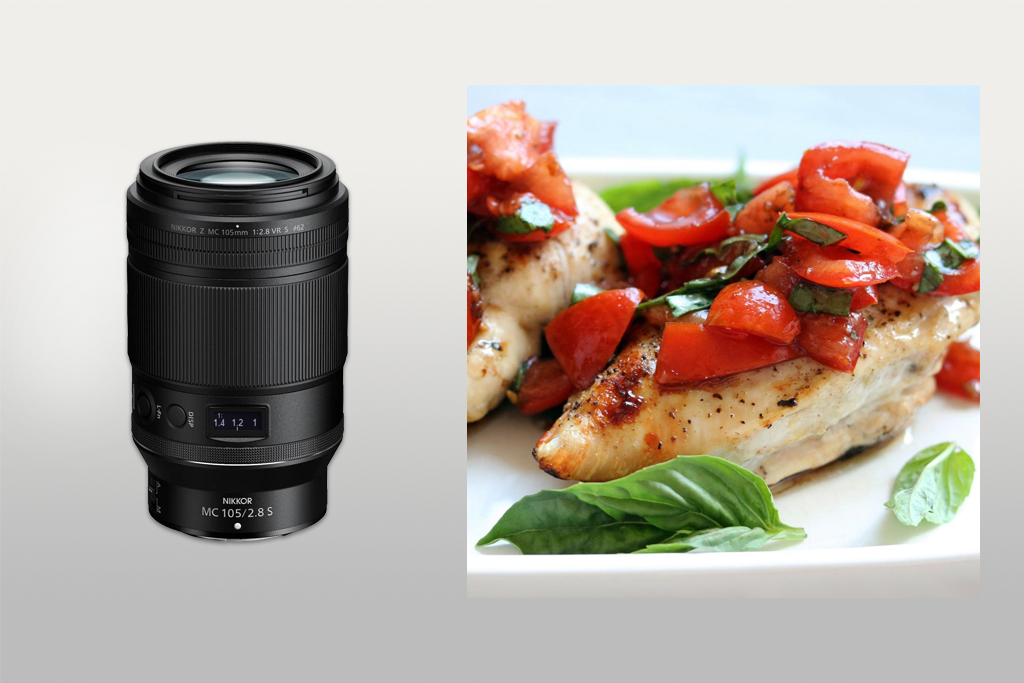
I was instantly blown away by the terrific sharpness of this lens. The 1:1 macro support lets me focus on the tiniest textures, be it the crust of a croissant or the little raspberry on a tart, showcasing their full glory.
Since it’s a 105mm lens, I can gain enough distance from the subject to avoid casting shadows on the subject, which can be a problem with wider macro lenses.
The bokeh is also absolutely beautiful. It lets me isolate the subject by creating a soft, dreamy backdrop with zero effort. The applied blur isn’t very aggressive, as the result still looks professional and clean. The provided color reproduction met all my expectations, so I didn’t have to make a lot of changes during post-processing.
Another benefit is – Vibration Reduction (VR). Taking macro shots in handheld mode can be very difficult, but I was able to receive highly sharp results without having to bring a tripod, particularly if the scene was well-lit. Such an approach is a lot more time-efficient and flexible.
Amazon: 300+ bought in past month
B&H: 3.8K+ sold in the past year
Adorama: 3K+ sold in the past year
Best Buy: 2.4K+ sold in past year
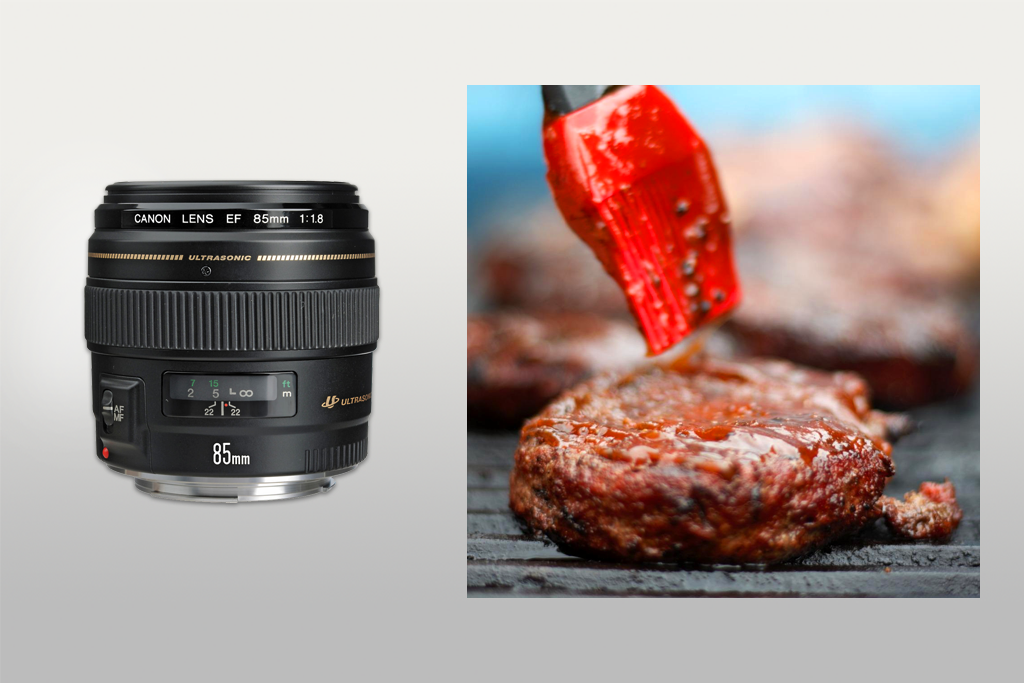
This food bokeh lens delivers terrific sharpness at wide apertures. I tend to pick f/2.2 or f/4 for food photography, based on the percentage of the shot I need to be in focus, and the Canon 86mm serves me perfectly in this regard.
Emphasizing garnishes, toppings, textures, or crystal sugars on desserts feels easy and natural. Even in handheld mode, the results look crisp and aesthetically pleasing, as I combined soft lighting, high subject sharpness, and warm depth.
The focus system is based on a USM (Ultra Sonic Motor) that runs quickly and silently, allowing me to easily tweak the composition and focal point on the fly. This is essential when taking photos of fresh dishes that quickly lose their aesthetic appeal.
However, when comparing this model to the best Sony lenses for food photography, you notice that its prime design makes it incapable of zooming in and out. This isn’t an issue in studio environments, but it can get in the way when shooting in limited spaces like a kitchen or small café.

The process of testing the best camera lenses for food photography with the FixThePhoto team had us dealing with croissants, salads, tea cups, and various other dishes. Along with Vadym Antypenko, Eva Williams, and Robin Owens, we experimented with a variety of photography styles, getting a better idea of what each option is capable of.
We used all of them in different scenarios, including top-down, 45-degree angles, close-ups, and full table compositions. We tried both prime and zoom lenses, from 50mm and 85mm models to macro and zoom glass.
We evaluated the sharpness wide open, checked the created bokeh, color accuracy, AF performance, and whether the lenses created distortions. Some options were a pleasant surprise in terms of versatility, while most others are designed for specific scenarios.
Robin focused on edge sharpness, which is what you expect from a full-frame sensor. Eva tested how the lenses held up in challenging lighting conditions. I prioritized learning how all the options performed in handheld mode in limited spaces, be it a restaurant setting or a compact kitchen.
During our testing, we snapped hundreds of pictures, wrote down the pros and cons of all the lenses, and measured the speed and accuracy of their autofocus systems when working with dynamic subjects like steam or sprinkles.
It was a very interesting endeavor that allowed us to put together this list to help you find the best lens for food photography available for a reasonable price.